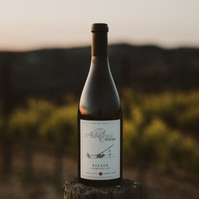|
|
 |

Albatross Ridge, Carmel Valley-Monterey County (California) Chardonnay, Estate 2013 ($55): I can still remember the first California Chardonnay that wowed me, back in the late 1970s. It was from an area we then referred to as the “South Central Coast,” but today would go by a more specific appellation. The wine was a fresh, flavorful Chardonnay with gentle fruitiness and wondrous texture. In the subsequent era of big, oaky California Chardonnays, and the next, reactive era of fresh but  unexciting un-oaked Chardonnays, I sometimes recalled that wine with nostalgia. Today, I discovered its stylistic cousin in the 2013 Albatross Ridge Estate Chardonnay from Carmel Valley in Monterey County. unexciting un-oaked Chardonnays, I sometimes recalled that wine with nostalgia. Today, I discovered its stylistic cousin in the 2013 Albatross Ridge Estate Chardonnay from Carmel Valley in Monterey County.
Many critics have blamed the use of oak for the monster California Chardonnays that for a period we grew accustomed to. Oakiness, in the guise of toasty flavors and firm, austere structure, was an obvious excess in many wines, but extreme ripeness leading to exaggerated tropical fruit aromatics and numbing alcohol was also a factor in that style. This Albatross Ridge Chardonnay in fact has been oaked -- it was barrel-fermented in French oak, 25 percent of which was new. It is an oaked Chardonnay, however it is not oaky.
What I believe makes a difference in this wine is its terroir, especially its climate. The Albatross Ridge vineyard is a windswept site with shale and limestone soils, situated just seven miles from the Pacific and stretching to an altitude of 1,250 feet. On the Winkler degree-days scale, it falls within the coolest category, Region I, and at the cool end of that category: Region I extends to sites with an annual heat-summation of up to 2500 degree-days and Albatross Ridge registers 1650 to 1950 degree-days annually, depending on the year. The temperature rarely exceeds 85 degrees.
Thanks to the cool climate, the 2013 Albatross Ridge Chardonnay has just 12.5 percent alcohol, having been harvested when the sugar accumulation in the grapes registered only 20.5 to 21.5 degrees Brix, compared to 23-plus Brix for grapes grown in warmer sites. And yet, the wine has full flavor development, and tastes in no way under-ripe.
Here’s what to expect when you taste this wine. The aromas suggest apple, pear and lemon-confit, and the flavors are similar, with a slight note of minerality. In your mouth the wine is dry and full-bodied with firm acidity at its core and yet a soft, seductive texture that immediately distracts you away from any consideration of acidity. The wine envelops your tongue with soft, creamy richness and yet is not at all heavy. The flavors speak clearly: this is a wine of fruit rather than subtlety. But that fruit comes draped in enticing silky viscosity, so that the wine is about so much more than just fruitiness.
Albatross Ridge was planted in 2008, and this 2013 wine is just its fourth release. Production is 410 cases. Albatross Ridge also produces two Pinot Noirs: 2013 Cuvée Vivienne ($40), a deceptively light Pinot Noir that reveals its tart red fruit intricacy gradually as you taste it; and 2012 Estate Pinot Noir ($55), which balances deeply-concentrated, dark fruit with a firm structure of tannin and seems built to age.
I suggest drinking the Chardonnay now and over the next couple of years. It expresses itself best, in my experience, when it is barely chilled so that its texture can sing. Be daring with the food pairing: I found it delicious with spicy beans and rice.
91 Points
|
 |
|